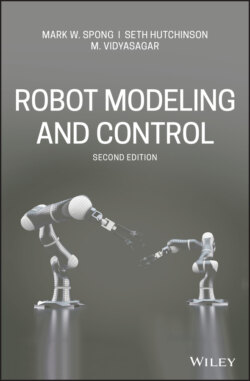Читать книгу Robot Modeling and Control - Mark W. Spong - Страница 37
Chapter 4: Velocity Kinematics
ОглавлениеTo follow a contour at constant velocity, or at any prescribed velocity, we must know the relationship between the tool velocity and the joint velocities. In this case we can differentiate Equations (1.1) and (1.2) to obtain
(1.5)
Using the vector notation and , we may write these equations as
(1.6)
The matrix J defined by Equation (1.6) is called the Jacobian of the manipulator and is a fundamental object to determine for any manipulator. In Chapter 4 we present a systematic procedure for deriving the manipulator Jacobian.
The determination of the joint velocities from the end-effector velocities is conceptually simple since the velocity relationship is linear. Thus, the joint velocities are found from the end-effector velocities via the inverse Jacobian
(1.7)
where J− 1 is given by
The determinant of the Jacobian in Equation (1.6) is equal to a1a2sin θ2. Therefore, this Jacobian does not have an inverse when θ2 = 0 or θ2 = π, in which case the manipulator is said to be in a singular configuration, such as shown in Figure 1.20 for θ2 = 0. The determination of such singular configurations is important for several reasons. At singular configurations there are infinitesimal motions that are unachievable; that is, the manipulator end effector cannot move in certain directions. In the above example the end effector cannot move in the positive x2 direction when θ2 = 0. Singular configurations are also related to the nonuniqueness of solutions of the inverse kinematics. For example, for a given end-effector position of the two-link planar manipulator, there are in general two possible solutions to the inverse kinematics. Note that a singular configuration separates these two solutions in the sense that the manipulator cannot go from one to the other without passing through a singularity. For many applications it is important to plan manipulator motions in such a way that singular configurations are avoided.
Figure 1.20 A singular configuration results when the elbow is straight. In this configuration the two-link robot has only one DOF.
